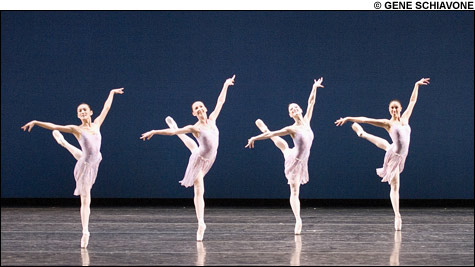
BALLO DELLA REGINA: Rie Ichikawa, Melanie Atkins, Lia Cirio, and Heather Myers.
|
“Classic Balanchine” as opposed to . . . “Jazz Balanchine”? “Porno Balanchine”? What was the alternative? Of course, if it’s a choice between “Classic Balanchine” and “Classic [fill in the blank],” I’ll take George every time. The titles of ballet repertory programs never matter; what counted last weekend is the three works Boston Ballet presented last weekend were well and in some cases superbly performed.
This “Classic Balanchine,” moreover, had crossing arcs. Like the company’s 2003 “All Balanchine” (my favorite title for any ballet program), it worked backward through his career, from Ballo della Regina (1978) to La Valse (1950) to The Four Temperaments (1946). In its dance style, however, it moved forward, from opera ballet interlude — very classic — to a decadent ballroom out of “The Masque of the Red Death,” and then to stripped-down sexual politics. You could call it “Mythic Balanchine.” Ballo gives us a frolic between a queen and her consort that could be the big finale for Titania and Oberon (or Titania and Bottom!) that’s missing from Balanchine’s A Midsummer Night’s Dream. La Valse sees Death claim the Girl in White from her mortal suitor, a story as old as storytelling and palpable in everything from the tale of Orpheus and Eurydice to Romeo and Juliet (where Romeo, all dark imagery in Shakespeare’s play, lures Juliet away from Paris). The Four Temperaments goes back farther than the humors of Greek and Roman writers and physicians, all the way to Adam and Eve. Yet all three works have carnival moments, too. “Circus Balanchine”?
Balanchine made the 17-minute Ballo della Regina (which was on that 2003 “All Balanchine” program, along with Monumentum pro Gesualdo, Movements for Piano and Orchestra, and Prodigal Son) as a bravura piece for Merrill Ashley, tall and true, in Arlene Croce’s words a “streaking cataract.” There’s nothing like Ashley doing those impossible turns while hopping on pointe in her polka variation, or floating aloft with one leg extended like an America’s Cup yacht hurtling downwind, or, after the Spanish national anthem turns into a circus galop, piqué-stepping off stage faster than a speeding bullet — as you can see on the Choreography by Balanchine DVD that’s now out from Nonesuch. She’s supported by a male partner (an unheroic Robert Weiss on the DVD) and a retinue of four demi-soloists in lavender and 12 corps ladies in Naiad blue, in music Giuseppe Verdi wrote for the requisite (in Paris) third-act ballet in Don Carlos. The choreography is all moonbeams and milkweed; right at the start the corps ladies do cheerleader pompon rolls with their hands. Croce on first acquaintance thought the ballet “doesn’t add up to much,” but it soon emerged for her as “one of Balanchine’s freshest visions.”
Lorna Feijóo wasn’t here for the company’s previous Ballo (she arrived in September of 2003), but she guested in the three spring-rep performances New York City Ballet gave in 2004, on Ashley’s recommendation, and drew a “fabulous” and “not to be missed” response from the New York Times’ Anna Kisselgoff. She was scheduled for opening night, but a cold kept her out of action all weekend, and Erica Cornejo filled in. An Argentine dancer who came to Boston Ballet from American Ballet Theatre last year, Cornejo is a bright, nippy performer with class, sass, and sex. She doesn’t have Ashley’s weight or gravity; where in the polka variation Ashley sat on those hopping pointe turns, underlining the transfer of weight, Cornejo whipped through them as if they were corps material. She spun on pointe like a top, nailed the freeze-frame succession of leg positions at the end, and generally zipped around like the Energizer Bunny, all with that big smile and a hint of mystery. Only in the piqué turns where the leg has to shoot out in arabesque did she falter. It wasn’t Ashley; it was Balanchine.
James Whiteside was scheduled to partner Feijóo; the company decided to leave him on with Cornejo, and they were fine together. A second soloist, he has the presence of a principal if not the full bravura technique. In this role, presence is everything; he looked regal, and he showed control in easing out of multiple pirouettes, quick turns and splits, authoritative beats and jumps, and lots of articulation. In the last section, he whipped off stage with such pace and power, I half expected to hear the PA announce that “James Whiteside has left the building.”
Saturday afternoon, Cornejo came out with her scheduled partner, corps member Gabor Kapin, less powerful than Whiteside but with a boyish spontaneity and well-delineated entrechats and brisés volés; they looked perky, almost conspiratorial together. Saturday evening Whiteside was back with a corps member Melissa Hough, who hadn’t been scheduled to dance the role at all. Built more like Ashley, and more of a modern than a classical ballet dancer (she’s been a rock in the company’s Jorma Elo commissions), she was tall and true enough. The smile was steady and confident; if some steps were hesitant (not the shooting leg in arabesque, however) and there were only flashes of Cornejo’s brio, she was unexpectedly melting in the pas de deux with Whiteside.